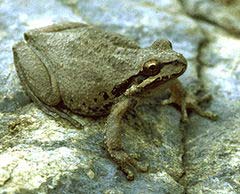 Hyla regilla, the Pacific Tree FrogBelonging to the Hylidae family, Pacific Tree Frogs live from southern B.C. south to California and east to Montana and Nevada. This frog can be recognized by sticky toe pads, rather than webbed feet, black stripes through each eye, a V or Y-shaped mark between its eyes, light-colored belly and dark spots on back and legs. Its color varies from a bronze brown to a lime green. Individuals can change color in green and brown tones in a few minutes. This color change, providing camouflage, is related to the temperature and amount of moisture in the air, not the background color as in most other amphibians and reptiles. This is an adaptable species that can live in coastal rainforests as well as ponds near treed areas of the interior dry belt. Despite being called a Tree Frog, this frog is mostly terrestrial and chiefly nocturnal, spending the day beneath logs, rocks, or other debris.
Hyla regilla, the Pacific Tree FrogBelonging to the Hylidae family, Pacific Tree Frogs live from southern B.C. south to California and east to Montana and Nevada. This frog can be recognized by sticky toe pads, rather than webbed feet, black stripes through each eye, a V or Y-shaped mark between its eyes, light-colored belly and dark spots on back and legs. Its color varies from a bronze brown to a lime green. Individuals can change color in green and brown tones in a few minutes. This color change, providing camouflage, is related to the temperature and amount of moisture in the air, not the background color as in most other amphibians and reptiles. This is an adaptable species that can live in coastal rainforests as well as ponds near treed areas of the interior dry belt. Despite being called a Tree Frog, this frog is mostly terrestrial and chiefly nocturnal, spending the day beneath logs, rocks, or other debris.
And though you may not spot a Pacific Tree Frog in the upcoming months, you may very well hear one. The Pacific Tree Frog is small and well-blended, but one of the loudest frogs around.
The rain call of the Pacific Tree Frog is such a great sound. We all know and love it. It is so great in fact, that when Hollywood wants to offer a frog sound in a movie, it is almost always the Pacific Tree Frog. This is even if the setting is the tropical jungle. Or somewhere in Africa.
Listen to the call of a Pacific Tree Frog
CONTEST: Free Oakland Zoo passes to anyone who can name a movie with this phenomenon! Leave your answers in the comments below.
Here is their script to land a mate, and perhaps a role in a movie, for your consideration:
CROAK OF THE PACIFIC TREE FROG
FADE IN:
EXT. Healthy Pond- oddly warm night in Oakland, CA
Territorial male frog enters pond and decides to protect pond section while attracting a female. He is the chorus master and has a dark and handsome throat patch. Usually solitary, he now finds himself wanting to connect with other males, forming a colony.
CHORUS MASTER FROG
Ribbit, Ribbit
Enter subordinate male frogs
SUBORDINATE MALE FROGS:
Ribbit, Ribbit, Ribbit
ALL FROGS:
Ribbit, Ribbit, Ribbit
(Keeping the two toned mating call, the last syllable rising in inflection seductively and rapid in sequence)
Foreboding music begins
Enter intruding males
SUBORDINATE MALE FROGS AND CHORUS MASTER
Rib….Rib….Rib….Rib
(Frogs now change to a one-toned “rain call”)
Exit intruding males, intimidated by the chorus of other frogs
SUBORDINATE MALE FROGS AND CHORUS MASTER
Ribbit, Ribbit, Ribbit
(Their mating calls continue)
Enter female frogs. They are smaller than the males. They hop up to males and touch them to indicate interest.
Fade to black. Ribbits and uplifting music rise.
THE END
Despite their famous and fabulous sounds, these frogs and amphibians, as a group, are in danger. They are very sensitive to changes in water quality and ecosystem health, and are therefore called an indicator species. Populations of all amphibians are declining world-wide even in un-touched areas such as Costa Rica. Scientists believe this is because of acid rain falling into ponds and lakes. Others say it is due to a fungus or global warming. Please advice, if you know better, or know anything we can all do to help. It just wouldn’t be spring (or summer) without that sound.
You can spot Pacific Tree Frogs and tadpoles at Arroyo Viejo Creek, running through the Oakland Zoo.
Tours and activities at the creek will take place at the Oakland Zoo’s Earth Day event on April 15th (www.oaklandzoo.org). Tours will be lead by The Watershed Awareness Project (www.thewatershedproject.org).
For more information about Global Warming, come see An Inconvenient Truth at The Oakland Zoo tonight (March 14th) at 7 pm.
Amy Gotliffe is Conservation Manager at The Oakland Zoo.

 Hyla regilla, the Pacific Tree Frog
Hyla regilla, the Pacific Tree Frog